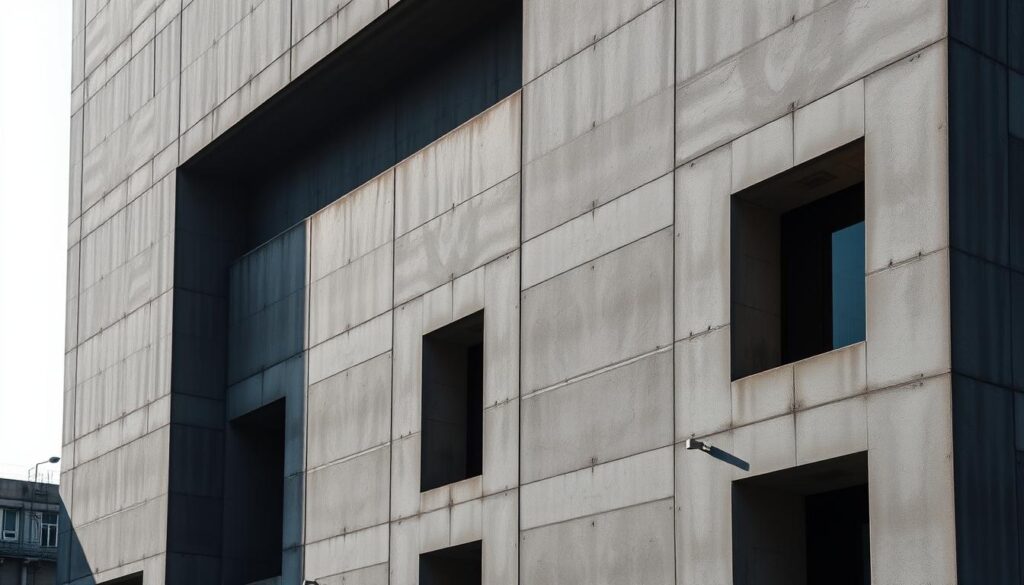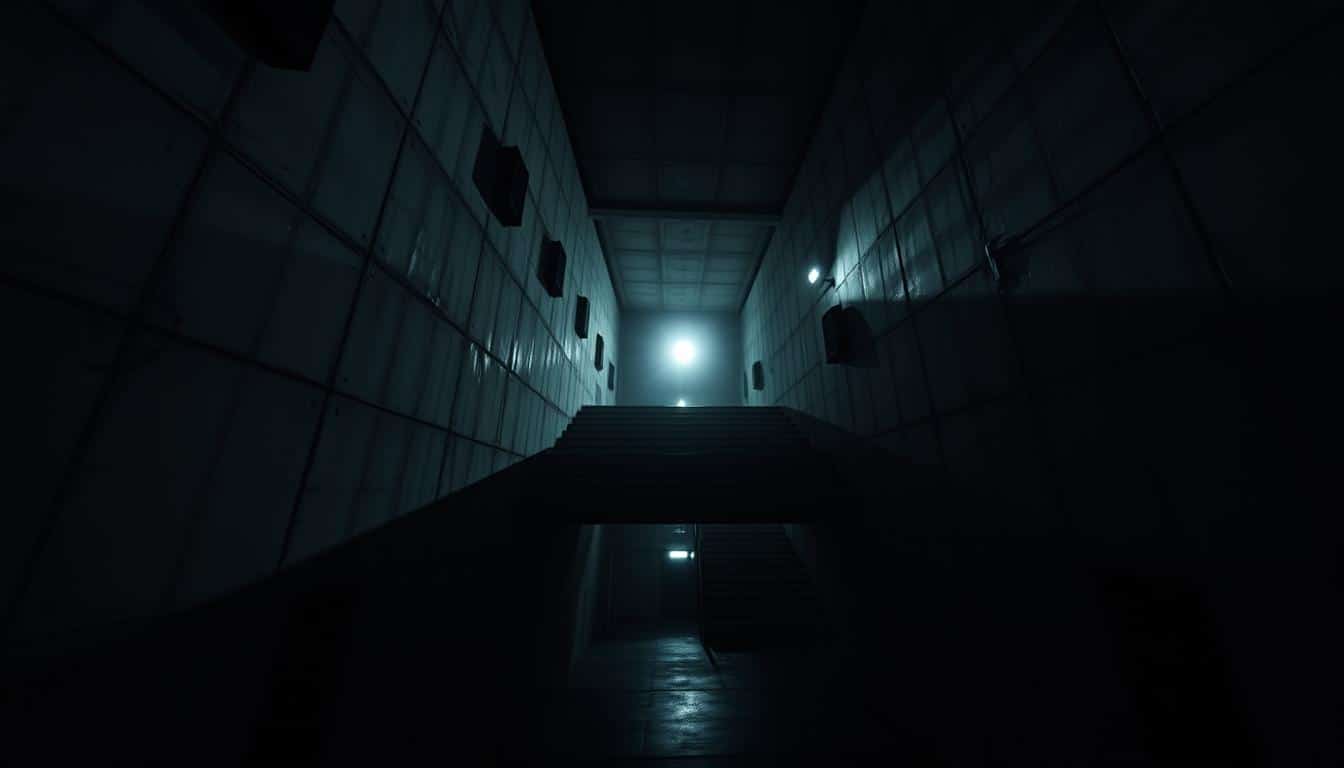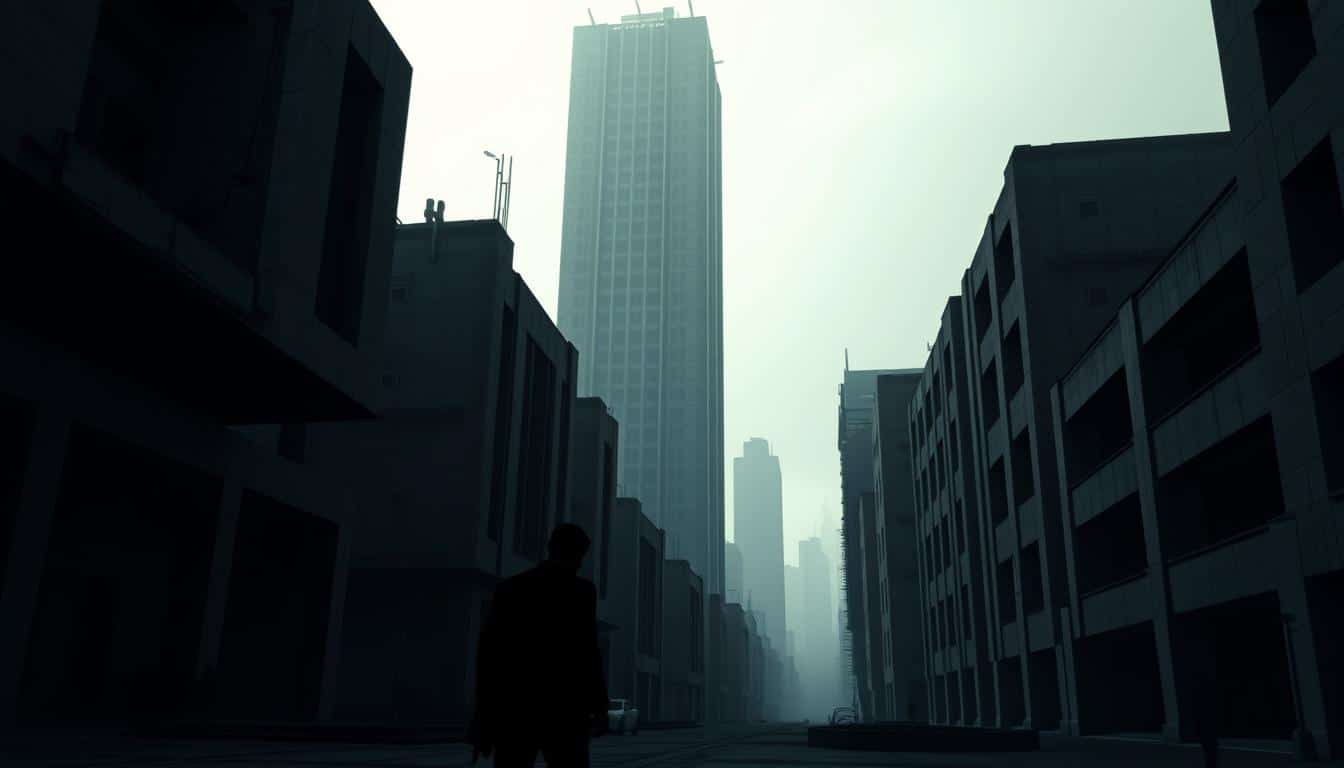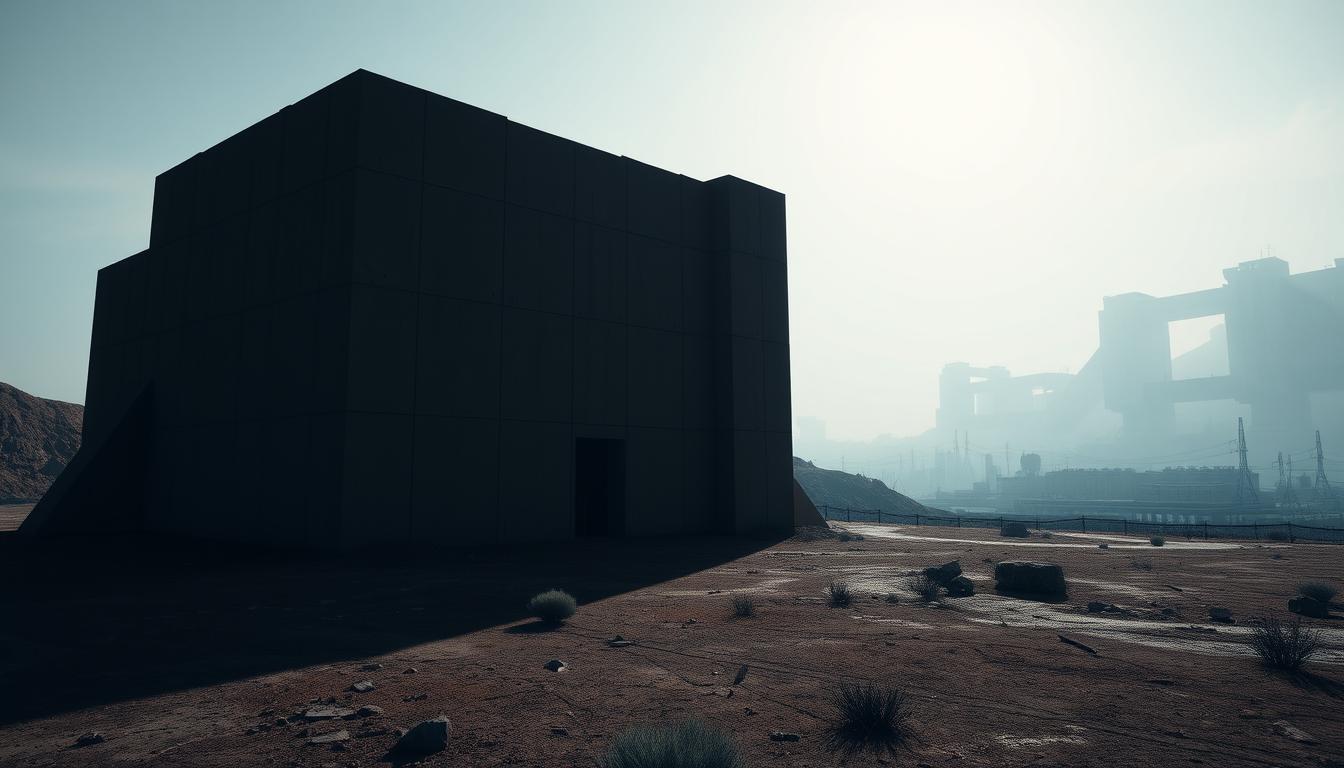Brutalist architecture has a big impact on many design fields, including video games. This is especially true for survival horror games. Here, brutalist designs help create a tense and emotional atmosphere, making the game more engaging for players.
By using raw materials and stark designs, brutalist architecture adds to the game’s mood. It makes players feel trapped and scared. This article will look at how these design choices improve survival horror games by making the gameplay and story deeper.
The Essence of Brutalism in Architecture
Brutalism is a standout movement in the world of architecture. It breaks away from earlier, more decorated styles. Its focus is on function and being true to the materials like concrete and steel. Brutalism shows off big, bold shapes, repeating patterns, and a simple yet tough look that speaks to both strength and lasting presence.
Definition and Characteristics of Brutalist Architecture
Brutalist architecture is known for its raw looks. Key features are:
- Geometric forms: Strong lines and angular shapes dominate the architectural canvas.
- Raw materials: The use of unfinished concrete and steel emphasizes the textural qualities of these substances.
- Repetitive elements: Patterns often emerge through repetition, adding visual rhythm to the buildings.
- Functional design: A focus on the functionality of spaces drives the overall layout and structure.
The style of brutalism isn’t just about looks. It’s about promoting social connections through building design.
Historical Context and Influence on Design
Brutalism came to life in the mid-20th century, during a time of big social changes and rebuilding after wars. Architects wanted to make spaces that met the needs of a changing world. Inspired by modernism and the need for quick rebuilding, this style ditched past decorations for a straightforward design approach. Brutalism’s influence goes beyond just buildings, reaching into interior design and even video game settings, where its bold structures stir deep feelings.

Introducing Brutalism in Video Game Design
Architectural styles deeply impact the feel of game worlds, shaping how users engage with them. Brutalism stands out sharply in video games, especially in the survival horror genre. It drives feelings of being alone and tense. The clear, simple features of brutalist design make games more gripping, essential in survival stories.
How Architectural Styles Influence Game Environments
The architecture in games sets the mood and affects player feelings. In games with a brutalist look, creators use:
- Raw materials and unfinished surfaces that seem real.
- Huge structures that make settings feel daunting and raise the stress.
- Open areas that leave players feeling exposed and alone.
Such design moves make games truly absorb players into a world filled with worry and danger.
The Appeal of Brutalist Aesthetics to Game Developers
Many creators of games are drawn to brutalist designs for their strong, eye-catching game scenes. They see value in the sharp contrast brutalism offers, helping tell compelling stories. They love:
- Big, sprawling worlds that test what players decide and see.
- The play of shadows and light that improve important game actions.
- A stripped-down style that builds up a sense of fear and waiting.
Using these elements, brutalist video games leave a lasting mark, pulling players into eerie, unforgettable places.
Brutalist Architectural Elements in Survival Horror Games
Brutalism has made a special spot for itself in survival horror games. It brings a raw, hard beauty to the screen. Games like “Silent Hill” and “Resident Evil” show how brutalist buildings make game worlds feel haunting. This design helps create a deep psychological tension for players.
Exploring Key Examples in Notable Titles
Brutalist architecture in games stands out through:
- Stark concrete structures that evoke feelings of desolation.
- Expansive, empty spaces that magnify the sense of isolation.
- Harsh lines and angles that create a visually jarring experience.
These design elements tell a story of horror that feels real to both characters and players. The settings make an atmosphere filled with danger. This draws players into a scary world made just for them.
Impact of Brutalist Design on Player Experience
Brutalist design deeply changes how players feel in horror games. Some key effects are:
- Feelings of entrapment arising from claustrophobic hallways.
- Heightened stress levels stemming from expansive and isolating environments.
- A constant sense of danger lurking within stark surroundings.
Players find themselves in scary places where danger could be anywhere. The mix of architecture and game play makes every moment tense. Each game journey is unique and impactful.
Psychological Effects of Brutalism in Survival Horror
Brutalism’s design principles deeply impact survival horror games’ psychology. Stark, imposing buildings set the perfect stage for fear and tension. These areas seem unfriendly, making the game more immersive.
Creating Atmosphere and Tension through Design
Brutalism brings a raw feel, making spaces not just eye-catching but unsettling too. Dark, big halls and concrete walls pull players into a world filled with unease. These settings mirror the story’s dread, making the game even tenser. Players become extra cautious, feeling more vulnerable and constantly on the lookout for danger.
How Brutalism Enhances Survival Horror Gameplay Mechanics
Survival horror’s mechanics are perfectly suited to brutalist design. Players manage resources while exploring fear-inducing environments. The stark design makes players feel fragile, significantly influencing their choices. This setting increases gameplay tension and makes players more engaged as they face brutalist horror’s psychological and physical challenges.
Iconic Survival Horror Games Featuring Brutalist Themes
Brutalist designs in iconic horror games enhance how players feel deeply immersed. Games like “Silent Hill” and “Resident Evil” show this through their settings and moods. These games mix architecture and horror to pull players into their worlds fully.
Case Study: Silent Hill and its Architectural Choices
“Silent Hill” uses brutalist themes to create a scary setting. The foggy streets and old buildings mirror the characters’ inner struggles. This approach highlights isolation, fear, and doubt, making the game not just scary but also deeply moving.
Case Study: Resident Evil Series and Dark Environments
The “Resident Evil” games skillfully mix brutalist designs with horror. Crumbled mansions and bleak labs set a terrifying background. This backdrop not only scares players but also ties into the story’s focus on survival and limited resources. It challenges players to face their fears in haunting, industrial settings.
Critiques of Brutalism in Video Games
Brutalist aesthetics can make survival horror games more immersive, but they also draw criticism. Some feel these stark environments detract from the game experience. It’s vital to consider these critiques to make sure the design helps the gameplay.
Negative Reactions from Players and Critics
Many players find too much brutalism can make game environments feel boring or repetitive. The frequent use of concrete and sharp angles could lessen their engagement. Also, not everyone likes the grim look often seen in brutalist designs. These reactions show how important it is to think about what players like when using this style.
Balancing Aesthetics with Gameplay Mechanics
For developers, adding brutalist design while keeping games balanced is tough. The setting should support the story and make gameplay better, not be a distraction. They must plan carefully so the bold looks add to, rather than hurt, how immersed players feel. Done right, brutalism can improve games and keep their unique design feel.
Comparing Brutalist and Other Architectural Styles in Gaming
Architectural styles shape the worlds in video games. Comparing gothic and brutalist elements in gaming reveals interesting contrasts. Each style triggers different feelings, affecting how players experience survival horror titles.
Contrasting with Gothic and Modern Design Elements
Gothic architecture is known for detailed designs and pointed arches. It creates a spooky feeling with shadows and dim lights. On the other hand, brutalism uses raw materials and simple shapes, valuing function over looks. This leads to different emotions for players. Gothic style makes players feel scared and intrigued, while brutalism feels cold and unwelcoming.
The Role of Architecture in Game Narrative
Architecture tells a part of the game’s story. Both gothic and brutalist styles add to the game’s theme, especially in survival horror. Gothic buildings make the game world seem mysterious and frightening. Brutalist structures make the player focus on surviving tough challenges. These styles add depth to game stories, making the worlds more engaging.
Future Trends: The Evolution of Brutalist Elements in Gaming
The gaming world is always changing. Now, more games are using brutalist themes to tell their stories. This means games are getting more intense and realistic. Soon, we might see even more brutalist styles in games as players want experiences that feel real and captivating.
Emerging Games that Embrace Brutalist Themes
New games are really leaning into brutalist themes. Horror games, for example, are using simple lines and raw materials. This makes for spooky and immersive settings. Games with these themes pull you in. They make you feel exposed and add a new layer to survival horror, making games more thrilling.
Anticipating Changes in Game Design Philosophy
Game developers are always looking ahead. They see a chance to mix brutalist elements with different styles. This can make games even more engaging. As players look for new experiences, developers are trying new ways to tell stories. This could change how we see and play horror games, making them even more interactive and exciting.
Conclusion
Summing up the role of brutalism in gaming, it’s evident that these designs boost the survival horror genre. They create a unique feeling of fear. This makes the game more engaging. The role of architecture in horror games is big. It changes how players interact and the story moves forward.
Also, as game makers try new visual styles, using brutalist designs is very exciting. This shows a bright future for horror games, where buildings play a big role in the game and how we feel. As we look ahead, brutalism is set to bring new and creative experiences. It will shine in the scary parts of our favorite games.



